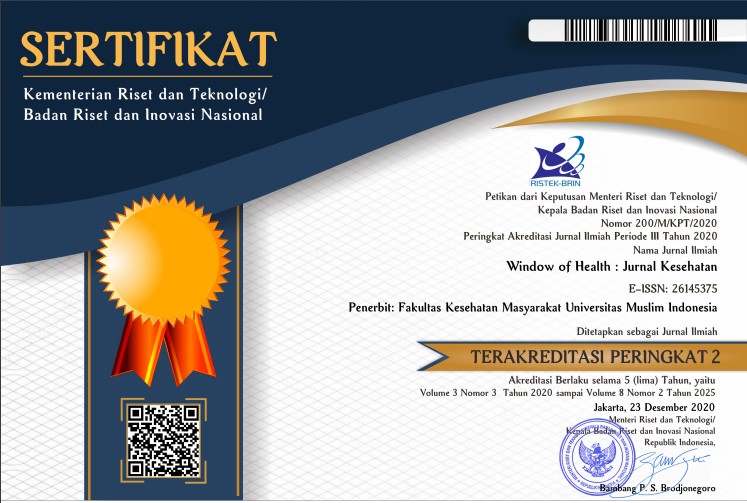Formulation of Body Odor Bacteria Inhibiting Deodorant Spray from Ethyl Acetate Extract of Klika Kesambi
Abstract
Acne is one of the skin damages caused by acne-causing bacteria. Flavonoids, saponins, and tannins in taro tubers can potentially have activity against acne-causing bacteria. This study aims to determine the formulation of extract transparent solid soap preparation that meets the characteristics and assess the activity of soap preparation as anti-acne against acne-causing bacteria. Taro tubers were extracted by maceration method. The extract was formulated as transparent solid soap preparations with variations in extract concentration, namely F0 0%, F1 2%, F2 4%, and F3 8%. The soap was evaluated for characteristics including organoleptic test, pH, moisture content, free fatty acids and alkali, mineral oil test, and foam stability test. Antibacterial activity testing of transparent soap extracts was carried out against acne-causing bacteria. The extraction results obtained an extract yield of 10.86%, the three extract formulas have transparent solid soap characteristics that meet the requirements. Soap preparation formula 1 has an inhibition zone of 21.66 ± 0.31 mm against P. acnes bacteria, 19.11±0.53 mm against S. epidermidis, 21.74±0.34 mm against S. aureus. Soap preparation formula 2 has an inhibition zone of 18.53±0.26 mm against P. acnes bacteria, 18.71±0.49 mm against S. epidermidis, 20.16±0.34 mm against S.aureus and soap preparation formula 3 has an inhibition zone of 19.03±0.68 mm against P. acnes bacteria, 19.93±0.86 mm against S. epidermidis, 22.75±0.59 mm against S.aureus. In conclusion, formula 2 with 2% extract concentration has the best soap characteristics and has the most optimal inhibition zone.
References
Lailiyah M, Sukmana PH, Yudha E, Ilmu I, Bhakti K, Kediri W. Formulasi Deodoran Roll on Ekstrak Daun Waru (Hibiscus Tiliaceus L) pada Konsentrasu 3%; 5%; 8% dan Uji Aktivitas terhadap BakteriI Staphylococcus Aureus Cendekia Journal of Pharmacy STIKES Cendekia Utama Kudus. Vol 3.; 2019. http://cjp.jurnal.stikescendekiautamakudus.ac.id
Lundström JN, Olsson MJ. Functional neuronal processing of human body odors. Vitam Horm. 2010;83:1-23. doi:10.1016/S0083-6729(10)83001-8
McManus K, Wood A, Wright MH, Matthews B, Greene AC, Cock IE. Terminalia ferdinandiana Exell. Extracts inhibit the growth of body odour-forming bacteria. Int J Cosmet Sci. 2017;39(5):500-510. doi:10.1111/ics.12403
Komala O, Wiendarlina IY, Rizqiyana N. Antibacterial activity roll on deodorant with Pluchea indica (L.) leaf extract against Staphylococcus epidermidis (Evans 1916 ) in vitro. IOP Conf Ser Earth Environ Sci. 2019;293(1):012031. doi:10.1088/1755-1315/293/1/012031
Indriaty S, Karlina N, Hidayati NR, Firmansyah D, Senja RY, Zahiyah Y. Formulasi dan Uji Aktivitas Deodorant Spray Ekstrak Etanol Herba Kemangi terhadap Bakteri Staphylococcus aureus. Vol 7.; 2022.
Teerasumran P, Velliou E, Bai S, Cai Q. Deodorants and antiperspirants: New trends in their active agents and testing methods. Int J Cosmet Sci. Published online March 21, 2023. doi:10.1111/ics.12852
Situmeang B, Malik Ibrahim A, Bialangi N, J.A Musa W, Silaban S. Antibacterial activity and phytochemical screening of Kesambi (Sapindaceae) against Eschericia coli and Staphylococcus aureus. Jurnal Pendidikan Kimia. 2019;11(1):14-17. doi:10.24114/jpkim.v11i1.13078
Ghosh P, Chakraborty P, Mandal A, Rasul MG, Chakraborty M, Saha A. Triterpenoids from Schleichera oleosa of Darjeeling Foothills and Their Antimicrobial Activity. Indian J Pharm Sci. 2011;73(2):231-233. doi:10.4103/0250-474x.91568
Kancherla N, Dhakshinamoothi A, Chitra K, Komaram RB. Preliminary Analysis of Phytoconstituents and Evaluation of Anthelminthic Property of Cayratia auriculata (In Vitro). Maedica (Bucur). 2019;14(4):350-356. doi:10.26574/maedica.2019.14.4.350
Machado BAS, Silva RPD, Barreto G de A, et al. Chemical Composition and Biological Activity of Extracts Obtained by Supercritical Extraction and Ethanolic Extraction of Brown, Green and Red Propolis Derived from Different Geographic Regions in Brazil. PLoS One. 2016;11(1):e0145954. doi:10.1371/journal.pone.0145954
Veranita W, Wibowo AE, Rachmat R. Formulasi Sediaan Deodoran Spray dari Kombinasi Minyak Atsiri Kulit Jeruk Kalamansi (Citrofortunella microcarpa) dan Ekstrak Teh Hijau (Camellia sinensis L) serta Uji Aktivitas Antibakteri. Jurnal Sains dan Kesehatan. 2021;3(2):142-146. doi:10.25026/jsk.v3i2.452
Masrijal CDP, Jarulis J, Sarah S. Formulasi dan Uji Aktivivitas Antibakteri Deodoran Spray Ethanol-Propilenglikol Mengandung Minyak Atsiri Kulit Jeruk Kalamansi (Citrofortunella microcarpa Cortex) Terhadap Staphylococcus epidermidis. Jurnal Ilmiah Pharmacy. 2022;9(2):64-74. doi:10.52161/jiphar.v9i2.420
Nahor EM, Rumagit BI, YTou H, Kesehatan Kemenkes Manado P. Perbandingan Rendemen Ekstrak Etanol Daun Andong (Cordyline Futicosa L.) Menggunakan Metode Ekstraksi Maserasi Dan Sokhletasi Comparison of the Yield of Andong Leaf Ethanol Extract (Cordyline Fruticosa L.) Using Maceration and Sokhletation Extraction Methods.
Tinggi Kesehatan Al-Fatah Bengkulu S, Dwi Putri Masrijal C. Formulasi Dan Uji Aktivivitas Antibakteri Deodoran Spray Ethanol-Propilenglikol Mengandung Minyak Atsiri Kulit Jeruk Kalamansi (Citrofortunella Microcarpa Cortex) Terhadap Staphylococcus Epidermidis. Vol 9.; 2022.
Kerwin BA. Polysorbates 20 and 80 used in the formulation of protein biotherapeutics: structure and degradation pathways. J Pharm Sci. 2008;97(8):2924-2935. doi:10.1002/jps.21190
Shamsudin NF, Ahmed QU, Mahmood S, et al. Antibacterial Effects of Flavonoids and Their Structure-Activity Relationship Study: A Comparative Interpretation. Molecules. 2022;27(4). doi:10.3390/molecules27041149
Kaczmarek B. Tannic Acid with Antiviral and Antibacterial Activity as A Promising Component of Biomaterials-A Minireview. Materials (Basel). 2020;13(14). doi:10.3390/ma13143224
Guimarães AC, Meireles LM, Lemos MF, et al. Antibacterial Activity of Terpenes and Terpenoids Present in Essential Oils. Molecules. 2019;24(13). doi:10.3390/molecules24132471
Copyright (c) 2024 Nur Khairi Jalil Genisa, Ismail, Maulita Indrisari

This work is licensed under a Creative Commons Attribution-NonCommercial-ShareAlike 4.0 International License.








